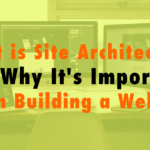What is Site Architecture and Why It’s Important When Building a Website
Read the full episode transcript below:
Read the full episode transcript below:
00:28 David Blackmon: Welcome to another episode of WP The Podcast, my name is David Blackmon.
00:35 Tim Strifler: And i’m Tim Strifler
00:38 David Blackmon: Today in episode 736 we’re going to talk about, what site architecture is and why it’s important when building a website. If you didn’t listen to yesterday’s episode, and you’re dropping in you know like a like a paratrooper going into battle, and you just hit this episode you may want to listen to 735 because we talk about the five most crucial pages, and we kind of allude to why this is important and stuff. So Tim why don’t you allow tell people what site architecture is, and then we’ll dive off into this topic?
01:24 Tim Strifler: Yeah absolutely. So site architecture is essentially, it’s like the table of contents for your website. It’s basically having a plan of what your website is about, what is going on, what pages, how the pages are interconnected and linked, and basically when you have a planned out site architecture it makes creating the content a lot easier, because you’re not just winging it and trying to figure out what do i want to say this here, do i want to put it here, and that sort of thing. And so for like a simple brochure website uh you know that’s five pages like the uh the five most crucial pages we talked about in yesterday’s episode. The site architecture is going to be pretty simple. It’s going to be rather uh flat but for like a really big website with a lot of content a lot of resources a lot of different areas of the site, well it’s going to be a really wide. You know think of it like a spider right? Where it’s like you have the top of it and it kind of comes down into these sections and these sections and then it’s like a pyramid. Uh in terms of all the different places where it gets interconnected and and how deep it goes. And so um so you could have uh a really uh kind of i guess shallow… Shallow kind of sounds has like a negative connotation, but like a shallow side architecture. But like a really simple site you know small business just needs an online presence and then you can have a really deep and really wide uh site architecture for a really large website. So that’s essentially it. So David will tell you why it’s important, and then i’ll tell you kind of my process for mapping it out and the way i think about it after that.
02:53 David Blackmon: Yeah and why it’s important i want to kind of add to what Tim was talking about and stuff in the side architecture. The reason it’s important is because it’s for your user you know. Your business you know what your goals are with your business, you know. Whether you want to sell them a service or you want to sell them a product? You want them to buy your t-shirt or your ad or whatever it is, that you’re selling products or services and you know your customer better than anybody. So if you know what gets them to quote unquote close the sale more than anybody, so you want to when they come to your site you want to take them on through this journey. Um you know, site architecture’s important on for two reasons. One is for the search engines and the other is for the customer. The customer is most important and if you focus on the customer, if you have the mindset of the most valuable relevant content for my avatar, my customer search engines like google are gonna know that. So it’s gonna be two prong and it’s gonna suit you really really well. So that when they come in Tim was talking about a shallow website, it you may have a brochure website, a locally owned business that’s been around forever and you only want to have them contact you, so when you’re thinking of a shallow website the flow may be the customer comes into your home page and whatever story you want to tell them on that home page might be directing them to fill out a form or pick up the telephone and call you. So that you can enter their data and your crm or your whatever you’re using for your customer info. It may be something as simple as that you may be wanting to take them to the contact page for example, because what’s most important for your business what you found is having them contact you. So that you can engage with them and stuff. So and that’s kind of an example of a shallow site. But Tim and i run some pretty complex. Will not run but we own some pretty complex and run e-commerce websites we have a lot of things going on on our website and we have a lot of you know you know potential ways for customers to find us you know. Whether it’s through tutorials whether it’s through our blogs whether it’s through uh referrals or our shop, our e-commerce shop, there’s so many ways. Well at the end of the day our goals are probably going to be pretty similar and pretty much the same you know. As any other site, our sites are just much more complex much more larger which is going to mean that really putting that side architecture together is super important and you know i’ll talk about some of the things that i use when starting out a brand new website, and also what I do, you know after the fact once you’ve got it up doesn’t websites aren’t set it and forget it. Google and search engines or algorithms are changing constantly so you have to really really really you know if this is your main form of revenue which for Tim and I it is our main form of revenue our websites. It’s like our our storefront in a small town so we have to stay on top of it. So updating it regularly, i’ll share with processes of what we do as well. And i’m actually going through it right now as we speak, so uh Tim why don’t you talk to him a little bit about what you were going to talk to him about.
06:29 Tim Strifler: Yeah, so the the way i approach site architecture is like a outline and outlining. I think it was like seventh grade i had a teacher a history teacher that like drilled into us the process of outlining, and organizing information right. Right and i thought it was so pointless and stupid at the time, but that’s something that stuck with me that ability to organize information from a high level and put it in an outlife format and that’s how i do everything. That’s how i write blog posts, it’s how i do site architecture, it’s how i uh when David and i are planning courses that we’re going to launch. It’s it’s yeah it’s basically how how we we organize the information and plan everything out. And so site architecture is no different. So if you think about your overarching purpose of your site right that’s that’s like the name of your site right. So for example it could be uh i’m in San Clemente California, so i’m just going to say San Clemente Web Design. Right, so you’re you might be you know uh Billy Bob’s Webdesign.com but your main kind of overarching focus is you know web design. Right that’s your that’s like your title tag and then you have you know the different main areas of your site, right? You have about Billy Bob’s, right and then you so that’s like your your uh um your if you’re thinking of an outline that’s like your your capital. A right and then you have your your services page. That’s like your your capital b and then within your services you might have web design. Right that’s your number one and then you might have SEO, that’s your number two. Then you might have uh email marketing management that might be your number three with under services, right? And then you have uh your your contact page that’s your number your your your capital c and like an outline format and stuff. And so basically it’s like a spider web of information organized in a hierarchy. And so hierarchy is key when it comes to good side architecture because you don’t want it just like, you know if you have a 50 page website all of them are at the same hierarchy, you want um some uh different levels to organize the content right. You might want only you know five top level pages and then you have you know each one of those might have two to five sub pages. Right, and so planning out that site architecture in an outline format helps you organize things into that hierarchy of top level pages and sub pages and stuff, and then within each of those pages you can then write a couple sentences of, you know what it’s about, what it’s going to accomplish what the goal of each page is. Right, and then from a certain perspective you could also bring in keyword research to then say these are the keywords the top level keywords that i’m targeting for this, for each one of these pages, and a general rule of thumb is uh, especially if you’re you’re newer to SEO, is you want each page to have one goal, one main topic, one kind of main, like set of keywords. Right for example you know San Clemente Web Design, Web Design in San Clemente, web designer in San Clemente. Right those are like the different ways of essentially saying the same thing and then you have another page that is uh San Clemente email marketer, right? And that’s that’s an entirely different page and it’s based off of that keyword research that you kind of plan out this side architecture so that’s the way i approach it in an outline format having it be clear and organized with the right hierarchy of top level and sub sub pages. And it’s all based on keyword research because remember as David mentioned, it’s important for users. You want it to be clear and organized but it’s also important for search engines. You don’t want to necessarily have pages on your site that uh you know talk a lot about something that no one really searches for right. And so you it’s like you want to build things around what what people are actually searching for. And again it’s like search what you do for search engines and what you do for users, even though we kind of talk about them in two different things they’re really one in the same, because the search engine wants what’s best for the user. And so again if it’s if the search engine is what people are searching for, then you’re going to naturally help the user best. Because that’s what people are searching for so you’re serving them while also serving the search engine. So hope that was clear? I know it’s kind of a lot.
11:03 David Blackmon: Yeah no it was clear, i think you know for me one of the things that i wanted to share when doing this process is, Tim uses an outline. I use mind mapping software, because you can you can set that hierarchy. He’s he’s 100 on the money about you know, the importance of of setting that structure in that hierarchy and stuff, and mind mapping software for whatever reason just clicks with my brain. It’s like yeah and you got to find out what clicks for your brain, you may be a pen and paper person i know lots of people who are pen and paper, and they need to write everything down. And they need to map it out that way. My brain, i am not a pen and paper person, i am a visual person. I need to see it and if i can see it flow it just makes sense to me. So you know, lean towards your power and stuff, um totally your strengths not power.. sorry uh wrong wrong poor word choice there um so..
12:18 Tim Strifler: Wrong podcast David, podcast…
12:23 David Blackmon: So you know now, this that’s just why side architecture is so important. And it’s not you don’t in this day and age, there’s a lot of competition. There are billions of website on websites on the internet. So the competition, competition is just.. speak english today David speak English… Competition is just so stiff and if you’re just being willy-nilly and throwing something up just because you can say “yeah i got a website” you know. And guess what, it may work for the people that you verbally tell it to in person “oh yeah i got a website go to mywebsite.com” whatever that is that may work. But i can promise you that’s going to be the only thing that works for you. Now if you want to compete and be San Clemente’s web designer then you’re going to need to make sure that you have it dialed in, and the content that you want to put on that website is solving those problems for people. You know it’s not just simply saying “hey i’m a web designer in san clemente here’s my address come hire me” you know. If you can you know put content one thing i was talking about yesterday. Yesterday’s episode was the services and products pages, it’s an opportunity for SEO do the keyword research like Tim said. And then write if you can’t write it yourself and if you’re not a good writer hire somebody to write it for you. You want to get as many words on those pages as possible it needs to make sense, it needs to solve problems and it needs to, um you know speak to the end user. It doesn’t need to be a bunch of gobbly [ __ ] that you just throw on a page to try to capture you know thinking that if if i use words so many times every other word is gonna do well. No it’s just not how it works if you need to hire a writer? hire a writer. And these are some pages where you can gain an advantage over your competitors and stuff because your competitors may just be bullet point listing out their services, of web design, graphic design, logo creation you know uh email marketing, seo. And that may be all they do is those 10 to 15 words. I can promise you it’s not you’re not going to win any SEO battles with something like that if you break down each one of those pages go into web design. Why it’s important why why is you know if you even talk about some of this stuff. Search engines are smart. You’re educating the customers they know it and stuff so it can benefit you in the long run and stuff. So site architecture is huge. I know these episodes have been a little bit longer than we typically you know do on WP The Podcast, but this is some of the most important information that’s going to be game changers for your business. And and we just wanted to try to cover it as much as we could in as much detail as we could. So if you’ve got any questions drop us a comment down in the in the in the comment section on YouTube, wherever you’re listening to this. Shoot us an email head over over to wpgears.com send us a message and we’ll gladly get back to you and stuff. Tim, we good?
15:45 Tim Strifler: We are good.
15:46 David Blackmon: All right, tomorrow we’ve got another great topic how to sell web design services effectively. If you’re struggling you better come tune in tomorrow, because we’re going to give you some goals. Until tomorrow, see you then.
15:51 Tim Strifler: Take care, bye.

Did you Enjoy this Episode?
- Will you consider sharing it online? Just click one of the share buttons below!
- Will you leave us a review? 🙂
- Have a question, or a topic request? Let us know in the comments below!
Want to Connect with David & Tim?
- David:
- Tim:








